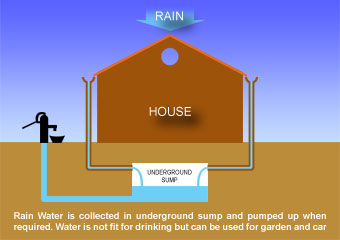 |
 |
 |
 |
| Volume
3 - Issue 12 DECEMBER 2005 |
|
Return to the Feature: God, Man And Water WATER HARVESTING Rainwater is the primary source of fresh water used by mankind. Rivers, lakes, and ground water are all secondary sources of fresh water, as they are all stores and channels of rainwater. Water harvesting is the name given to an organised effort to collect rainwater and make use of it later, in the place where the rain falls. Water harvesting is nothing new. In South India, for ages, people used to collect water in tanks and use them for irrigation. Indeed, for centuries a good part of the agriculture in the State of Tamil Nadu used to be based on tank water. It was only with the advent of British rule when big dams came to be constructed, that people in many places began to depend on water distributed through canals. Water harvesting is needed not merely for agricultural purposes but also for providing drinking water, especially in urban areas. The city of Shillong in India is the capital of the State Meghalaya. This State is located in the North East part of the country, and the word Meghalaya literally means the Abode in the Clouds; no wonder, for the State is all high mountains. Shillong receives very heavy rainfall but the irony is that the people there suffer from drinking water shortage! Why? Because all the rainwater runs quickly down the slopes into the valleys below. The people there have therefore started collecting water that falls on the sloping roofs and storing them in huge canisters for use, especially during the non-monsoon period. Many cities in India have become so urbanised that the rainwater nowadays flows through drains, and is lost. Decades ago, houses in the city of Madras [now Chennai], for example, used to have wells from which water used to be drawn not only for drinking but also for other household use also. These days when drinking water itself is in short supply, water availability for other purposes is almost zero – there is no ground water anymore since there is no recharging; all the rainwater flows away through drains into the sea. This is precisely where rain harvesting becomes important. Figures below shows schematically, how this harvesting is done. Right now, such harvesting is not mandatory but soon it might have to be made so.
Return to the Feature: God, Man And Water
|
| You can write to us at : h2h@radiosai.org |
Vol 3 Issue 12 - December 2005
|
Best viewed in Internet Explorer - 1024 x 768 resolution. |
DHTML Menu by Milonic. |

